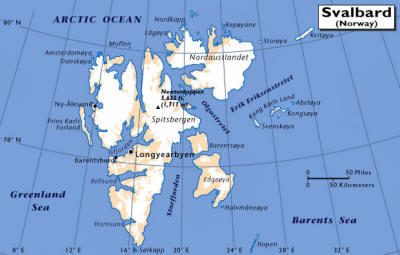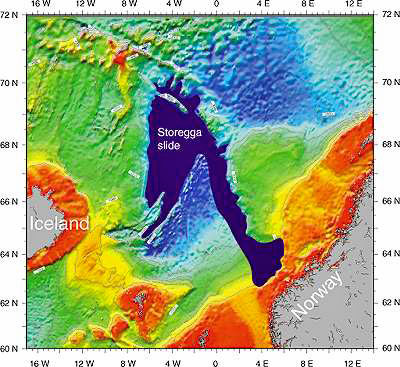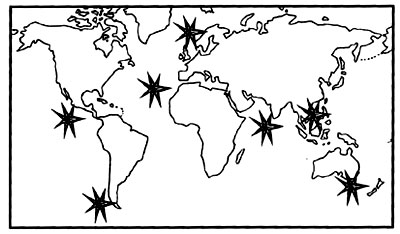|

by RH
08 May 2008
from
Sott Website
"Time passes, but they're
always five to seven years from the bomb."
Shlomo Brom
Israel's
deputy national security adviser under former Prime
Minister Ehud Barak

Angel by William
Blake
As Israeli politicians continue to beat
the war-drums over what they (now alone) claim to be an imminent
threat from a nuclear-capable Iran, very similar hysterical rhetoric
is being used in the attempt to convince us of a very different if
equally catastrophic threat to life on earth - "climate change".
The doomsayers tell us we have ten
years, at most, to reverse the inevitable destruction or face the
dire consequences of cities under water, earthquakes, tsunamis and
the dreaded, if not racist, tropical diseases moving north.
While
researching this article I
came across a blog that made a very
salient point:
Quite apart from the science, one thing I find suspicious about
climate catastrophism is how there's supposed to be this massive and
terribly deleterious change ahead of us, and yet (by what strikes me
as an amazing coincidence) we are always said to still be capable of
stopping it but only - and here the speaker invariably assumes the
urgent air of an infomercial voice-over - if we act right this very
minute.
This is strange, given that we're dealing with what (on the
catastrophist account) seems to be a slippery-slope doomsday
scenario that has been building up since the Industrial Revolution.
Given the long time-frame and massive uncertainties involved, you'd
think that predictions of the exact timing of the "point of no
return" must involve a fairly significant margin of error.
In light
of that, it's odd that there doesn't seem to be even one
climate-change affirmer out there who's saying,
"Rats! I hate to tell
you this guys, but it's one or two (or ten or fifty) years too late
and there's basically nothing we can do now."
Perhaps adding:
"So we
might as well just go out in style - let's everyone head out to the
SUV dealership!" Or "Let's get 10,000 of our best friends together
and jet over to Bali for a big wingding!"
On the other hand, there are thousands of them who seem to think
we're just a few years away from this point of no return...
And that's it: We're always a few years away from the point of no
return, whether it's Iran, climate, or some other "catastrophic"
event we must act now before it is too late.
-
What if Iran already
has the bomb?
-
What if we're already past the point of no return?
-
What will you do, what will They do then?
Which brings me to
this curious article:
One thing Microsoft founder Bill Gates can't be accused of is sloth.
He was already programming at 14, founded Microsoft at age 20 while
still a student at Harvard. By 1995 he had been listed by Forbes as
the world's richest man from being the largest shareholder in
Microsoft, a company which his relentless drive built into a de
facto monopoly in software systems for personal computers.
In 2006 when most people in such a situation might think of retiring
to a quiet Pacific island, Bill Gates decided to devote his energies
to his Bill and Melinda Gates Foundation, the world's largest
'transparent' private foundation as it says, with a whopping $34.6
billion endowment and a legal necessity to spend $1.5 billion a year
on charitable projects around the world to maintain its tax free
charitable status.
A gift from friend and business associate,
mega-investor Warren Buffett in 2006, of some $30 billion worth of
shares in Buffet's Berkshire Hathaway put the Gates' foundation into
the league where it spends almost the amount of the entire annual
budget of the United Nations' World Health Organization.
So when Bill Gates decides through the Gates Foundation to invest
some $30 million of their hard earned money in a project, it is
worth looking at.
No project is more interesting at the moment than a curious project
in one of the world's most remote spots, Svalbard. Bill Gates is
investing millions in a seed bank on the Barents Sea near the Arctic
Ocean, some 1,100 kilometers from the North Pole.
Svalbard is a
barren piece of rock claimed by Norway and ceded in 1925 by
international treaty (see map below).

On this God-forsaken island Bill Gates is investing tens of his
millions along with the Rockefeller Foundation, Monsanto
Corporation, Syngenta Foundation and the Government of Norway, among
others, in what is called the 'doomsday seed bank.'
Officially the
project is named the Svalbard Global Seed Vault on the Norwegian
island of Spitsbergen, part of the Svalbard island group.
...
Now is it simply philosophical sloppiness?
What leads the Gates and
Rockefeller foundations to at one and the same time back
proliferation of patented and soon-to-be Terminator patented seeds
across Africa, a process which, as it has in every other place on
earth, destroys the plant seed varieties as monoculture
industrialized agribusiness is introduced, and at the same time
invest tens of millions of dollars to preserve every seed variety
known in a bomb-proof doomsday vault near the remote Arctic Circle
'so that crop diversity can be conserved for the future' to restate
their official release?
The subheading of the above article summarizes:
"Bill Gates,
Rockefeller and the GMO giants know something we don't."
Indeed.
As the Bali Climate talks face imminent collapse and the EU
threatens to boycott U.S.-led climate talks next month unless
Washington accepts negotiating deep reductions of global-warming
emissions, we're reminded again that we're just
10 years away from
the "tipping point".
If one actually takes the time to look at the
various scenarios that the IPCC report studied you'll see that even
under the most drastic cuts all models still
predict accelerated
warming. Even if emissions were to halt by 2100 the warming would be
here to stay and if cuts were agreed to it would only delay the
warming until some future time beyond 2100. Just who are they trying
to save the earth for? Just their grand kids?
Let's face it, it's
all or nothing. Either we cut emissions to zero now or we kiss our
collective asses good-bye, because why bother going through all the
hoopla if, in the end, it's not going to make one bit of difference.
Besides, according to a new study, 'Global Warming is naturally
caused and shows no human influence':
Climate scientists at the University of Rochester, the University of
Alabama, and the University of Virginia report that observed
patterns of temperature changes ('fingerprints') over the last
thirty years are not in accord with what greenhouse models predict
and can better be explained by natural factors, such as solar
variability.
Therefore, climate change is 'unstoppable' and cannot
be affected or modified by controlling the emission of greenhouse
gases, such as CO2, as is proposed in current legislation.
These results are in conflict with the conclusions of the United
Nations Intergovernmental Panel on Climate Change (IPCC) and also
with some recent research publications based on essentially the same
data. However, they are supported by the results of the US-sponsored
Climate Change Science Program (CCSP).
The report is published in the December 2007 issue of the
International Journal of Climatology of the Royal Meteorological
Society [DOI: 10.1002/joc.1651].
The authors are Prof. David H.
Douglass (Univ. of Rochester), Prof. John R. Christy (Univ. of
Alabama), Benjamin D. Pearson (graduate student), and Prof. S. Fred
Singer (Univ. of Virginia).
...
Co-author S. Fred Singer said:
"The current warming trend is simply
part of a natural cycle of climate warming and cooling that has been
seen in ice cores, deep-sea sediments, stalagmites, etc., and
published in hundreds of papers in peer-reviewed journals.
The
mechanism for producing such cyclical climate changes is still under
discussion; but they are most likely caused by variations in the
solar wind and associated magnetic fields that affect the flux of
cosmic rays incident on the earth's atmosphere.
In turn, such cosmic
rays are believed to influence cloudiness and thereby control the
amount of sunlight reaching the earth's surface - and thus the
climate."
Our research demonstrates that the ongoing rise of
atmospheric CO2 has only a minor influence on climate change. We
must conclude, therefore, that attempts to control CO2 emissions are
ineffective and pointless. - but very costly.
Or maybe there's
an ulterior motive:
The fate of the Earth hangs in the balance in Bali, but the issue is
not whether humanity will succumb to a "climate crisis," or how the
international community might craft a successor to the tattered
Kyoto Accord (Let's call it KyoTwo).
The real theme of this United
Nations gabfest - like that of its 12 predecessors, and of the
hundreds, if not thousands, of related meetings - is whether
globalization and trade liberalization will be allowed to continue,
with a corresponding increase in wealth, health and welfare, or
whether the authoritarian enemies of freedom (who rarely if ever
recognize themselves as such) will succeed in using environmental
hysteria to undermine capitalism and increase their Majesterium.
Any
successor to Kyoto will be rooted in hobbling rich economies,
increasing the poor world's resentment, unleashing environmental
trade warfare, and blanketing the globe with rules and regulations
that benefit only rulers and regulators.
Bali is not about climate;
it symbolizes the continued assault on freedom by those who seek - or pander to
- political power under the guise of concern for
humanity.
Well, one can argue over whether trade "liberalization" brings
wealth, health and welfare.
Enslaving those who were once
subsistence farmers into sweatshops doesn't bring wealth, health and
welfare any more than cows redeem the benefits of factory farming.
But the writer has a point:
"Bali is not about climate; it
symbolizes the continued assault on freedom by those who seek - or
pander to - political power under the guise of concern for
humanity."
And just like the invasion of Iraq was at first billed as
saving us from Weapons of Mass Destruction and then morphed into
saving Iraqis from a brutal tyrant to now saving Iraqis from
themselves, so with a climate "saving" scenario morph into ever
shifting reasons for saving ourselves
from some "catastrophe":
Unlike most apparently intractable problems, which have a tendency
to go away when examined closely and analytically, the climate
change predicament just seems to get bigger and scarier the more we
learn about it.
Now we discover that not only are the oceans and the atmosphere
conspiring against us, bringing baking temperatures, more powerful
storms, floods and ever-climbing sea levels, but the crust beneath
our feet seems likely to join in too.
Looking back to other periods in our planet's history when the
climate was swinging about wildly, most notably during the last ice
age, it appears that far more than the weather was affected. The
solid earth also became restless, with an increase in volcanic
activity, earthquakes, giant submarine landslides and tsunamis.
At
the rate climate change is accelerating, there is every prospect
that we will see a similar response from the planet, heralding not
just a warmer future but also a fiery one.
Several times in the past couple of million years the ice left its
polar fastnesses and headed towards the equator, covering much of
the world's continents in ice sheets over a kilometer thick, and
sucking water from the oceans in order to do so. As a consequence,
at times when the ice was most dominant, global sea levels were as
much as 130m lower than they are today; sufficient to expose land
bridges between the UK and the continent and Alaska and Russia.
Each time the ice retreated, sea levels shot up again, sometimes at
rates as high as several meters a century.
In the mid 1990s, as part
of a study funded by the European Union, we discovered that in the
Mediterranean region there was a close correlation between how
quickly sea levels went up and down during the last ice age and the
level of explosive activity at volcanoes in Italy and Greece.
Now here's the kicker.
How does global warming trigger volcanic
eruptions?
The answer lies in the enormous mass of the water pouring into the
ocean basins from the retreating ice sheets.
The addition of over a
hundred meters depth of water to the continental margins and marine
island chains, where over 60% of the world's active volcanoes
reside, seems to be sufficient to load and bend the underlying
crust.
This in turn squeezes out any magma that happens to be hanging
around waiting for an excuse to erupt. It may well be that a much
smaller rise can trigger an eruption if a volcano is critically
poised and ready to blow.
...
As sea levels climb higher so a response from the world's volcanoes
becomes ever more likely, and perhaps not just from volcanoes.
Loading of the continental margins could activate faults, triggering
increased numbers of earthquakes, which in turn could spawn giant
submarine landslides.
Such a scenario is believed to account for the
gigantic
Storegga Slide, which sloughed off the Norwegian coast
around 8,000 years ago, sending a tsunami more than 20 meters (66ft)
high in places across the Shetland Isles and onto the east coast of
Scotland.
Should Greenland be released from its icy carapace, the
underlying crust will start to bob back up, causing earthquakes well
capable of shaking off the huge piles of glacial sediment that have
accumulated around its margins and sending tsunamis across the North
Atlantic.
...
Maybe the Earth is trying to tell us something. It really would be
worth listening before it is too late.
Well, you can read the rest of the article which pretty much spells
out our doom - unless we act now! All this sounds pretty scary in
comparison to the previous evils of coal fired power plants and cow
farts.
But don't worry! Catastrophe can be avoided:
Epic Flood Triggered Ancient "Big Chill," Study Says
An epic gush of fresh water into the North Atlantic slowed a deep
ocean current and triggered a century-long chill in Europe and North
America some 8,200 years ago, according to a new study.
The finding confirms scenarios suggested by previous models of the
ancient climate and should raise confidence in predictions made
about how the oceans will respond to Greenland's rapidly melting
glaciers, an outside expert said.
...
The researchers identified a section of the core that corresponds to
a hundred-year period around 8,200 years ago. The chemistry of the
sediment there is unlike that from any other time over the past
10,000 years, Kleiven said.
...
The new findings suggest that the changes in the ocean circulation
pattern and cooling of the ocean surface happened over the course of
a few decades at most, Kleiven noted.
"The response we see in these deep-ocean changes [is that] they
occur on timescales which are rapid enough [that] they could impact
human societies," she said.
While no immediate freshwater supply the size of lake Agassiz exists
today, Greenland's rapidly melting ice sheets could potentially slow
the deepwater current and affect global weather patterns.
A slowing could thrust large portions of Europe and North America
into a mini ice age and weaken the monsoon rains in Africa and Asia.
"That's the rain that a couple billion people rely on for crops,"
Alley said.
...
To study the possibility of future freshwater-induced disasters,
scientists build computer models based on their understanding of
past events like the cooling 8,200 years ago.
The new sediment core findings, Alley noted, suggest that these
climate models are accurate.
And this, he added, is good news. When scientists plug the melting
rates of Greenland's ice sheets into these models, they indicate
catastrophe will most likely be avoided.
And of course all you have to do is cut back on emissions. Our
rulers and regulators will decide what's best for us.
Now, I refer back to the previous catastrophe article in which it's
mentioned that the Storegga Slide occurred about 8,000 years ago.
Compare this to the above 8,200 year event and one immediately
concludes they refer to the same time period.
So did the draining of
Lake Agassiz cause a monumental slide in the deep ocean off of
Norway? Perhaps. But is it likely?
From
Wikipedia:!
The three Storegga Slides count among the largest recorded
landslides in history.
They occurred under water, at the edge of
Norway's continental shelf (Storegga is Norwegian for "the Great
Edge"), in the Norwegian Sea, 100 km (62 mi) north-west of the Møre
coast. An area the size of Iceland slid, causing a very large
tsunami in the North Atlantic Ocean.
This collapse involved a 290 km
(180 mi) stretch of coastal shelf, with a total volume of 3,500 km3
(840 mi3) of deposited debris. Based on carbon dating of plant
material recovered from sediment deposited by the tsunami, the
latest incident occurred around 6100 BC.

This brings me to the story of the
Blind Men and the Elephant.

A Jain version of the story says that six blind men were asked to
determine what an elephant looked like by feeling different parts of
the elephant's body.
The blind man who feels a leg says the elephant is like a pillar;
the one who feels the tail says the elephant is like a rope; the one
who feels the trunk says the elephant is like a tree branch; the one
who feels the ear says the elephant is like a hand fan; the one who
feels the belly says the elephant is like a wall; and the one who
feels the tusk says the elephant is like a solid pipe.
A wise man explains to them
All of you are right. The reason every one of you is telling it
differently is because each one of you touched the different part of
the elephant. So, actually the elephant has all the features you
mentioned.
Is there a wise man in the room?
Referring back to
Engdahl's
article, do
Bill Gates,
Rockefeller and
the GMO giants know
something we don't? Let's assume they do. If they knew something was
going to happen that was so catastrophic that they'd need to keep a
seed vault, why wouldn't they tell the rest of humanity?
Perhaps,
just perhaps
they don't have our best interests in mind:
"Asteroids which pass close to the Earth have been fully recognized
by mankind for only about 20 years.
Previously, the idea that
substantial unobserved objects might be close enough to be a
potential hazard to the Earth was treated with as much derision as
the unobserved ether. Scientists of course are in the business to
establish broad principles (e.g. relativity) and the Earth's
supposedly uneventful, uniformitarian environment was already very
much in place.
The result was that scientists who paid more than lip
service to objects close enough to encounter the Earth did so in an
atmosphere of barely disguised contempt. Even now, it is difficult
for laymen to appreciate the enormity of the intellectual blow with
which most of the Body Scientific has recently been struck and from
which it is now seeking to recover.
"Confronted on many occasions in the past by the prospect of
world-end, national elites have often found themselves having to
suppress public panic - only to discover, too late, that usual
means of control commonly fail.
Thus an institutionalized science is
expected to withhold knowledge of the threat; a self-regulated press
is expected to make light of any disaster; while an
institutionalized religion is expected to oppose predestination and
to secure such general belief in a fundamentally benevolent deity as
can be mustered."
Letter written by Dr. S V M Clube dated June 4, 1996 from the office
of Dr. P. A. Charles, former Head of Astrophysics of the University
of Oxford, to Ms. Victoria Cox, then Chief, Physics and BMD
Coordinator of the European Office of Aerospace Research and
Development.
Now, if the elite wanted to both prepare for a worldwide catastrophe
while at the same time prevent the public from panicking, how do you
think they would go about the task?
They wouldn't want to keep
everything secret because secrets have a nasty habit of leaking out
and breeding 'dangerous' (that is 'realistic') conspiracy theories.
They would probably choose to be up front about what they were doing
while making sure to obscure and distort their reason for doing it.
They would, for example, spread disinformation by promoting 'crazy'
(that is 'unrealistic') conspiracy theories.
They would also be most
desirous of ensuring that the public believe that something can be
done to prevent disaster, thereby suppressing panic and even
benefiting from public accolades at their unsurpassed leadership
abilities in securing our future.
All the while they would be
preparing for a very different catastrophe, one in which the mass of
humanity will likely be destroyed, but which will spare the elites
with their seed vaults and
underground bases?
Far fetched? Maybe.
But then just what happened to those
missing Pentagon trillions? And
the billions disappearing yearly into the
black budget?
But getting back to 8,200 years ago. What really happened to cause
the climate to shift, mega-tsunamis to wash over the continents, and
the gigantic Storegga slide?
If cosmogenically generated tsunami are so rare, certainly within
the time-span of human civilization, then a paradox exists because
evidence for such events certainly appears often in the geological
record and in human legends.
Traditionally, the difficulty in
discriminating between fact and fiction, between echoes of the real
past and dreams, has discouraged historians and scientists from
making inferences about catastrophic events from myths or deciphered
records. Yet, common threads appear in many ancient tales.
Stories
told by the Washo Indians of California and by the Aborigines of
South Australia portray falling stars, fire from the sky, and
cataclysmic floods unlike any modern event. Similar portrayals
appear in the Gilgamesh myth from the Middle East, in Peruvian
legends, and in the Revelations of Saint John and the Noachian flood
story in the Bible.
Victor Clube of Oxford University and
William
Napier of the Royal Observatory of Edinburgh have pieced together
consistent patterns in ancient writings, which they interpret as
representing meteoritic showers 3,000-6,000 years ago.
One of the more disturbing accounts has been compiled from these
legends by Edith and Alexander Tollmann of the University of Vienna,
who believe that a comet circling the sun fragmented into seven
large bodies that crashed into the world's oceans 8,200 ± 200 years
ago. This age is based on radiocarbon dates from Vietnam, Australia
and Europe. The impacts generated an atmospheric fireball that
globally affected society.
This was followed by a nuclear winter
characterized by global cooling. More significantly, enormous
tsunami swept across coastal plains and, if the legends are to be
believed, overwashed the centre of continents. The latter
phenomenon, if true, most likely was associated with the splash from
the impacts rather than with conventional tsunami run-up. Massive
floods then occurred across continents.
The event may well have an element of truth.
Figure 8.9 below, plots the
location of the seven impact sites derived from geological evidence
and legends. Two of these sites, in the Tasman and North Seas, have
been identified as having mega-tsunami events around this time. The
North Sea impact centre corresponds with the location of the Storegga slides described in Chapter 6.

Kristan-Tollmann
Fig. 8.9
Here, the main tsunami took
place 7,950 ±190 years ago. One of the better dates comes from wood
lying above tektites in a sand dune along the South Coast of
Victoria, Australia.
The tektites are associated with the Tasman Sea impact and date at
8,200 ±250 years before present. These dates place the Deluge Comet
impact event - a term used by the Tollmanns - around 6200 BC.
This event does not stand alone during the Holocene. It has been
repeated in recent times - a fact supported by Maori and Aborigine
legends from New Zealand and Australia.
--Edward A. Byrant, from "More Recent Evidence from Legends and
Myths", a review of Deluge Comet Impact Event 8,200 ± 200 years ago
(Kristan-Tollmann and Tollmann, 1992)
These scientists aren't the only ones
to suggest such catastrophes.
They're called catastrophists, a group of British scientists who
question many of the aspects of Darwinian evolution and argue that
life on Earth and the geology of the planet have been constantly
reshaped by asteroid strikes and other external shocks.
...
[A] leading catastrophist is Mike Baillie, an expert in early
climate change, at Queen's University in Belfast. Mr. Baillie starts
from scientific grounds, such as the measurement of tree rings and
the examination of ice core samples, and then delves into mythology
to find out if legends can throw light on the extraordinary, perhaps
catastrophic climatic events revealed by the records.
In a book,
"Exodus to Arthur," Mr. Baillie asks whether the simultaneous
emergence of legends about dragons in China and angels in Western
mythology were common reactions to the appearance of a comet.
Mr. Baillie points out that contemporary accounts at the time of the
Black Death, which killed one third of Europe's population in the
14th century, mentioned droughts, floods, masses of dead fish,
earthquakes, sheets of fire, stinking smoke, huge hailstones and
blasts of hot wind - all possible descriptions, he said, of a close
encounter with an asteroid or comet.
One record spoke of a large bright star over Paris, and another said
that the sky looked yellow and the air red because of burning
vapors. Tree ring studies reveal evidence of massive climate
disturbance at the same time, Mr. Baillie added.
Recently Nature featured
an article on Mammoth tusks:
Bullet-like pieces of what is thought to be an ancient meteorite
shower have been found embedded in mammoth tusks and bison bone.
The discovery of the 2 - 5 millimeter holes left by meteorites opens
a window into a impact event thought to have happened over Alaska
and Russia tens of thousands of years ago. And it could provide a
whole new way to chart impacts from space.
The fragments, found in seven mammoth tusks and the skull and horns
of a Siberian bison, match the geochemical composition of iron
meteorites. "We think that the micrometeorites came from an
air-burst of a meteor 30,000 to 34,000 years ago," says Richard
Firestone, co-author of the study and a chemist at the Lawrence
Berkeley National Laboratory in California. "We think a wave of
meteoric material sprayed the region."
And there's also the
Holocene Impact Working Group:
Most astronomers doubt that any large comets or asteroids have
crashed into the Earth in the past 10,000 years. But the
self-described "band of misfits" that make up the two-year-old
Holocene Impact Working Group say astronomers simply have not known
how or where to look for evidence.
Scientists in the working group say the evidence for such impacts
during the past 10,000 years, known as the Holocene epoch, is strong
enough to overturn current estimates of how often the Earth suffers
a violent impact on the order of a 10-megaton explosion. Instead of
once in 500,000 to 1 million years, as astronomers now calculate,
catastrophic impacts could happen every few thousand years.
At the southern end of Madagascar lie four enormous wedge-shaped
sediment deposits, called chevrons, that are composed of material
from the ocean floor. Each covers more than 100 square kilometers
with sediment hundreds of meters deep.
On close inspection, the chevron deposits contain deep-ocean
microfossils that are fused with a medley of metals typically formed
by cosmic impacts. And all of them point in the same direction -
toward the middle of the Indian Ocean where a newly discovered
crater, 29 kilometers, or 18 miles, in diameter, lies 3,800 meters,
or 12,500 feet, below the surface.
The explanation is obvious to some scientists. A large asteroid or
comet, the kind that could kill a quarter of the world's population,
smashed into the Indian Ocean 4,800 years ago, producing a tsunami
at least 183 meters thigh, about 13 times as big as the one that
inundated Indonesia nearly two years ago.
The wave carried the huge
deposits of sediment to land.
But notice the dates: 30,000 to 34,000 years ago.
And we also have
8,200 years ago. Is there a connection? Yes, all three numbers
30,000, 34,000, 8,200, and even 4,800 fit into an approximate
4,200
year cycle (within error) coinciding with time periods going back
from the present.
So, do Bill Gates, Rockefeller and the GMO giants know something we
don't? All of the evidence, cross-referenced with a psychological
analysis of political and corporate leaders, argues very strongly
that they do.
So the difficult question with which we are faced is
not:
'When are we going to do something about climate change?' but
rather: 'When are we going to wake up to the fact that our political
and corporate leaders have never acted in our best interests, and to
trust them on "climate change" not only risks our own future but
that of countless generations to come.'
|





